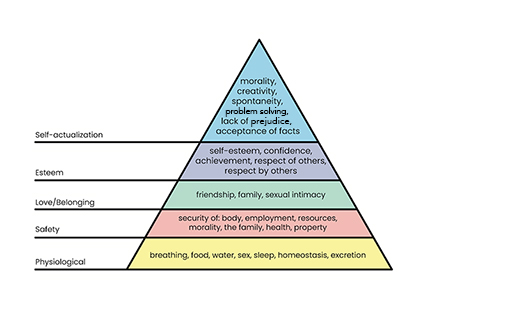4.3 Creating ‘safe’ places
Perryman et al. propose that:
Feeling safe is essential for mental wellbeing and every educator has a responsibility to ensure their classroom [learning environment] is a safe space for learners. This can help with the development of positive relationships that are conducive to learners’ wellbeing.
Just like other concepts that you have explored in this week’s content, ‘feeling safe’ can of course mean different things to different people. Maslow’s (1943) hierarchy of needs (see Figure 6) is a common model used in education as it highlights the importance of both physical and psychological safety.
Perryman et al. (2022) further suggest that educators can help promote learning environments as places of safety through:
- the design of the learning environment: for example, the level of background noise or potentially distracting visual stimulation
- the design of the session: for example, the pace of work, length of work sessions, availability of breaks or sequence of activities
- the facilitation of collaboration, including group work, and engagement (this is touched on in Week 7).
By creating safe and inclusive spaces for your learners, you can help foster a supportive environment where they feel free from judgement, critical opinions or micro-aggressions (indirect, subtle or unintentional discrimination against members of a marginalised group) from others. This is of particular importance for those learners who may already feel marginalised (Yee, 2019). Ideally, with this in place, learners will also feel supported to ask for help when needed.
Activity 6 Creating a safe and inclusive space for your learners
Consider the learning environment in which you work. Does it provide a safe and inclusive space for your learners? Are there ways in which you might adapt the environment to support a safe space or ways in which you could help your learners feel safe?
For the physical environment, think about things like furniture, noise levels, comfort and adaptability. For feelings of safety, think about things like establishing ground rules, addressing challenging behaviours, promoting acceptance and inclusivity.
Discussion
To create a safe environment, you may have considered aspects such as the following:
- Furniture: Is there somewhere comfortable to sit, rather than a less comfortable plastic chair? Can the furniture arrangement be adapted to facilitate group and individual work and make it less threatening. For example, in a one-to-one session can you and the learner sit next to each other to reduce feelings of anxiety rather than at opposite ends of a table?
- Quiet: Is the learning space free from loud noises or external disruptions?
- Comfort: Does the space have windows, fresh air, a comfortable temperature? Can learners make a drink if needed?
- Adaptability: If preferred, is it possible for you and the learner to ‘walk and talk’ rather than staying seated somewhere; this can sometimes help reduce barriers to conversations.
- Online environments: If your learning environment is online, consider establishing guidelines for safety and comfort at the start of each session, such as when to enable use of microphones, cameras and chat boxes; the use of anonymous whiteboards, polls and breakout rooms for opinions to be safely expressed as well as the recording or non-recording of elements of sessions.
To create feelings of safety and inclusivity, you may have considered aspects such as:
- Establishing ground rules: For example to cover courtesy, acceptable language and behaviour towards one another, confidentiality, etc.
- Addressing challenging behaviours: How will you deal with micro-aggressions, racist or sexist remarks, inappropriate behaviour? Is there a Diversity and Inclusion or Anti-harassment policy for your institution that can be referred to?
- Promoting acceptance and inclusivity: Have you learned to pronounce the names of your learners correctly? Do you use gestures of interest, inclusion and caring to boost learners’ confidence and self-esteem?



